Imagine if you could trade like a pro without spending years learning charts and strategies! That’s exactly what copy trading makes possible.
In this guide, we’ll break down everything you need to know about copy trading: what it is, the main types, which platforms offer the best features (not just exchanges), and a step-by-step walkthrough on how to start.
What is copy trading and how it works
The “copy trading” meaning is pretty much clear from the name itself. Copy trading is an investment approach where you automatically replicate the trades of experienced traders in real time. The person whose trades you copy is called the lead trader, and you are the copy trader.
You can connect your exchange account to a copy trading crypto platform or use the built-in feature on exchanges that support it. Once you choose a trader to follow, your account automatically mirrors their trades, opening and closing the same positions.
This happens through secure API connections, so you remain in full control of your funds. You can choose fully automated systems that copy trades instantly or manual ones where every action requires your confirmation.
There are two options for copy trading in crypto:
- Spot copy trading lets you automatically copy trades on the spot market. It’s safer and easier for beginners.
- Futures copy trading allows you to copy trades on futures contracts, where traders use leverage to profit from both rising and falling prices.
Of course, lead traders don’t share their trades live just to show how cool they are. They usually earn a percentage of followers’ profits (Binance offers 10%, Bybit up to 30%) and sometimes a cut of trading fees or special platform rewards for high performance or large follower counts.
Is copy trading profitable?
Answering this question is like trying to predict whether a top Binance trader will still be successful next month. No matter how much we like him, we can’t know for sure. Either way, you’ll still get his ROI — whether it’s positive or negative.
Popular copy trading platforms in 2025
When choosing the best copy trading platform, consider a few key factors: which cryptocurrencies it supports, how transparent traders’ statistics are, and whether the platform is regulated.
Binance copy trading is integrated directly into the world’s largest cryptocurrency exchange. Other major exchanges like Bybit, OKX, and Bitget also offer built-in copy trading features with options for both spot and futures copy trading.
Besides exchange services, there are also separate platforms made just for copy trading:
- eToro describes itself as the first “social network for traders” because it lets users interact and share insights in a news feed. Each trader’s profile includes detailed stats on past performance, risk score, and trading history. Besides crypto, this copy trading app also lets you mirror stock and ETF trades.
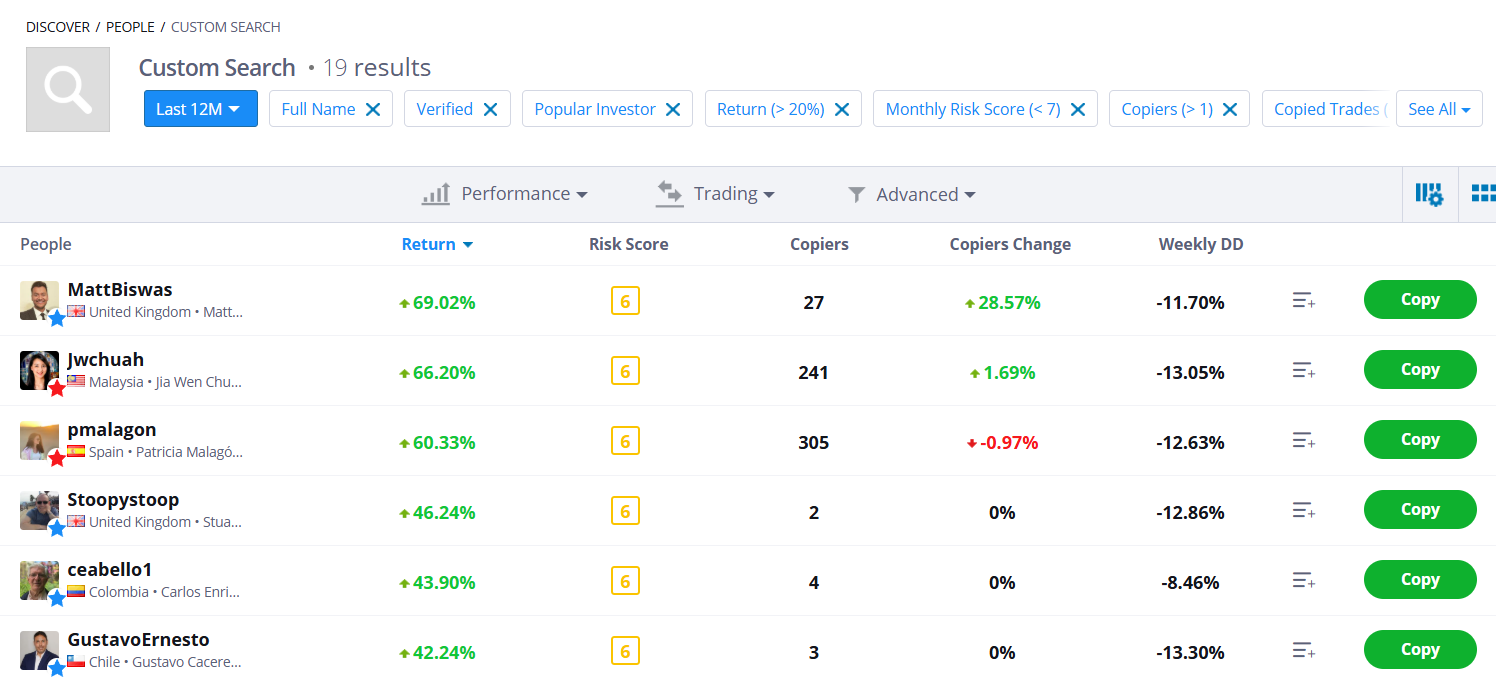
- 3Commas allows users to copy the strategies or trades of automated bots. You can select pre-made bots from experienced traders and connect them to exchanges like Binance, Bybit, or Coinbase via API.
- FOREX.com, a well-known traditional broker, now offers forex copy trading and crypto copy trading through CFDs (Contracts for Difference, financial derivatives that let you speculate on price movements without owning the underlying asset).
Here’s a comparison table of the platforms listed above.
Step-by-step copy trading guide on Binance
To visualize the process, let’s look at how Binance copy trading works. Most other exchanges follow a similar process, with only small differences in layout or terminology.
Step 1. Go to the copy trading section
From the Binance homepage, go to “Trade”, then to “Copy Trading” . There you’ll see spots and future copy. Both types have similar interfaces and settings. The only difference is the use of leverage.
Step 2. Browse the list of top traders
You’ll see a list of top-performing traders for different time periods. You can sort them by PNL (total profit), ROI (return in %), MDD (maximum drawdown), and AUM (total funds under management).
ROI is the most common indicator to assess consistency. Always check ROI over 90 days, not just 7, to identify reliable performers.
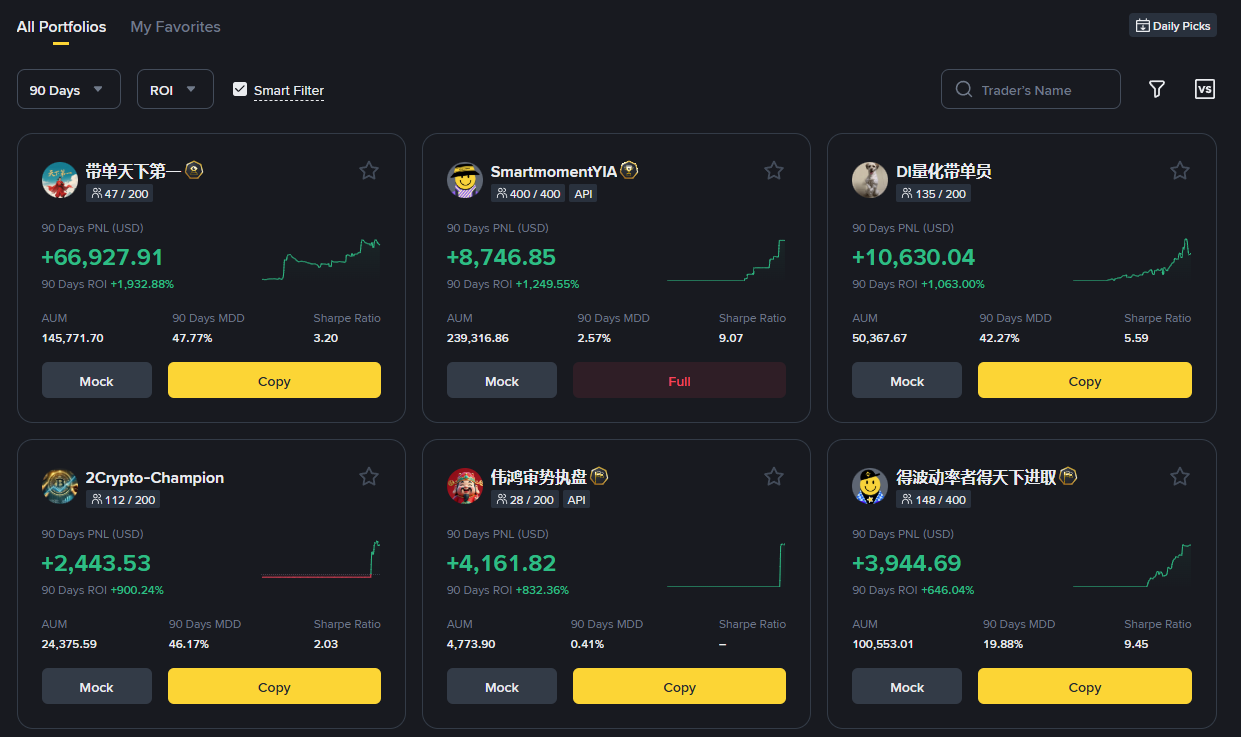
Step 3. Analyze a trader’s profile
Click on a trader’s name to open detailed stats. Look at how long they’ve been trading, how many people are copying them, their win rate, total trades, and average drawdown (MDD).
If the trader’s profile says “full”, it means all available copy slots are taken. You’ll have to wait or pick another trader.
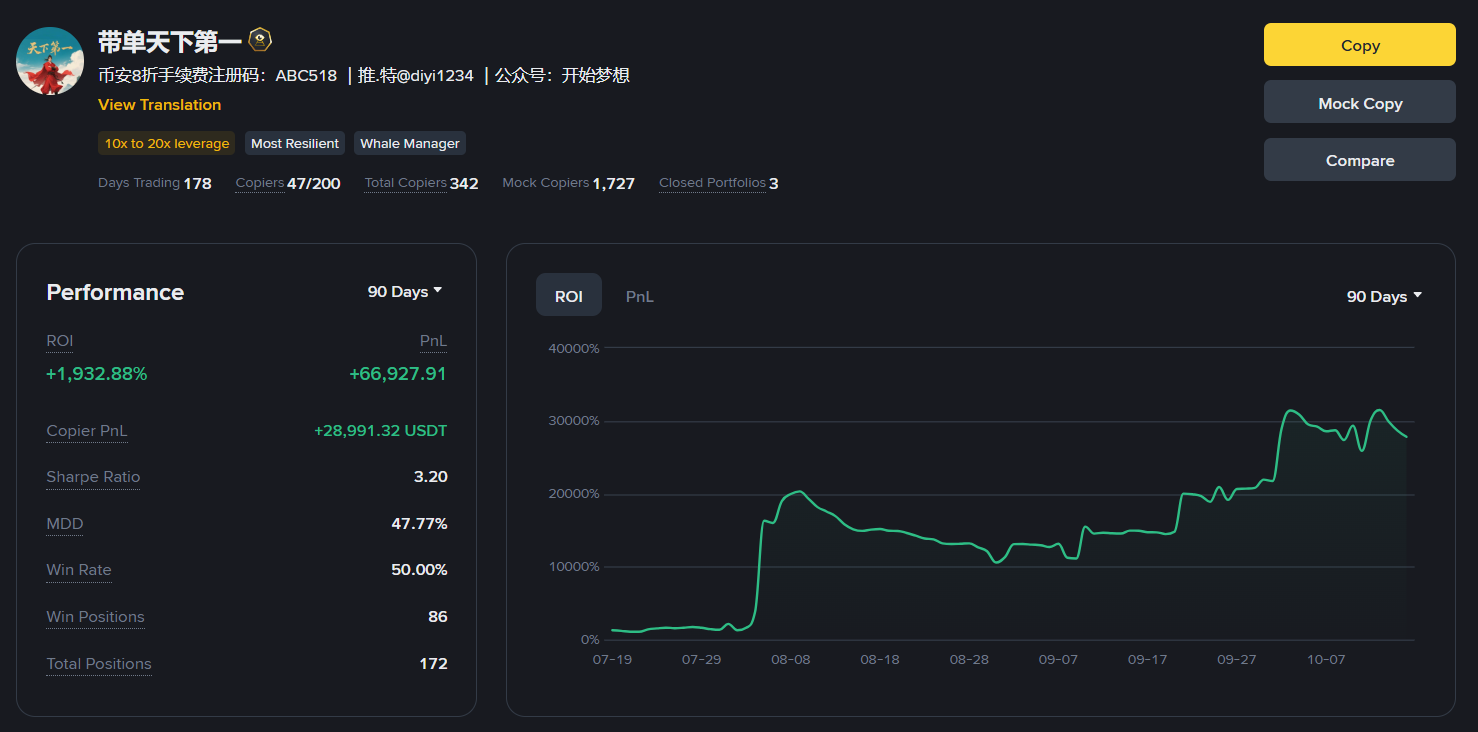
Step 4. Choose a copying mode
Once you find a suitable trader, click “Copy” next to their profile. You’ll see two copying modes:
- Fixed Amount: you set a fixed sum per trade.
- Fixed Ratio (percent): you trade the same percentage of your balance as the trader does. For example, if the trader invests 10% of their $10,000 balance ($1,000), and you have $100, you’ll invest $10.
Fixed ratio is better, as it mirrors the trader’s strategy and risk level accurately, while a fixed amount can distort results.
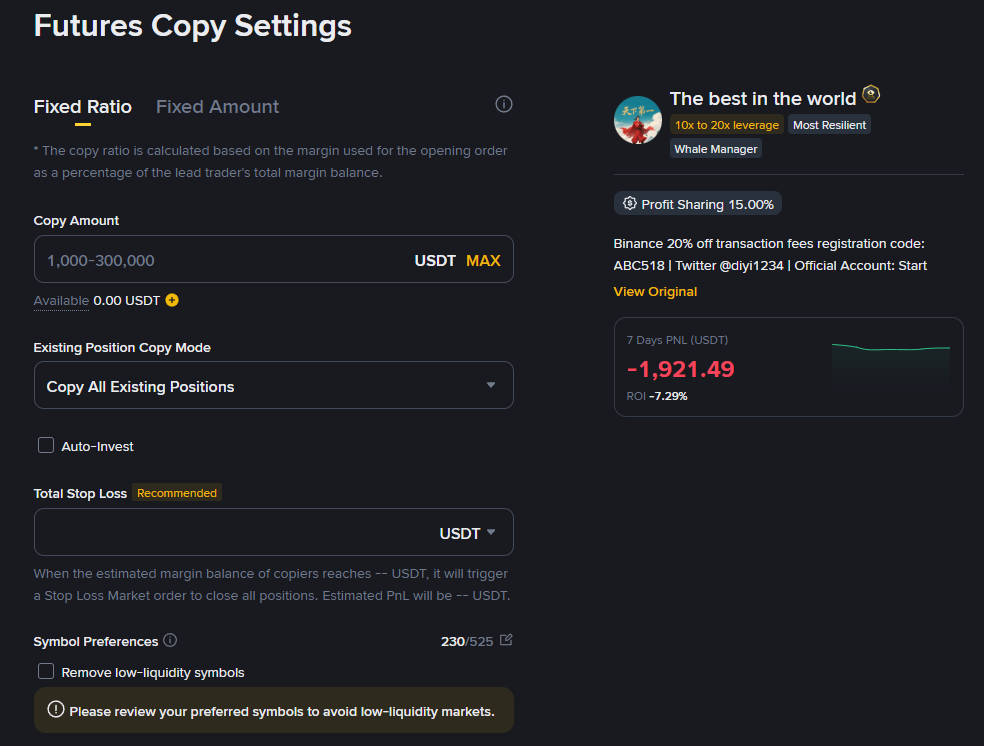
Step 5. Set up your copy trading parameters
You’ll now customize your copy settings:
- Investment amount from $1,000 up to $300,000
- Total stop-loss for all trades with this trader
- Margin mode: isolated, cross, or same as the trader (for futures only)
- Leverage: trader’s one or your own (for futures only)
- Take-profit / stop-loss percentages per position
- Max cost per order — the maximum % of your balance per trade
If you’re a beginner, it’s better to keep the default settings and not change much. Focus on picking a solid trader instead.
After that, just hit ‘Copy’ and let’s go!
Tips for successful copy trading
Unfortunately, you can just fully rely on lead traders and do nothing. You should always stay alert and have your own copy trading strategy. Here are some practical steps to make your copy trading really successful:
- Take your time to analyze lead traders carefully. How did they perform in both bull and bear markets? How deep was their maximum drawdown? Consistency matters more than short-term gains. And most importantly, make sure their risk level fits your comfort zone.
- Set limits and stop-losses. Always decide in advance how much you’re willing to lose. Use built-in stop-loss tools to automatically pause copying if losses hit your threshold.
- Monitor and adjust. Check your portfolio weekly or biweekly to ensure their strategy still makes sense. If a trader’s performance slips or risk increases, don’t hesitate to stop copying and look for a better fit.
Here’s what Reddit user HaxtonSale advises:

Benefits of copy trading
You might start thinking that copy trading is worth a try. So now is a good time to go over its potential pros and cons.
- Time efficiency. For those who aren’t ready to spend days staring at charts, this is the biggest advantage. Plus, you’ll avoid emotional decisions driven by fear or hype.
- Learning. Watching how experts react to market swings teaches you how they size positions, manage risk, and adjust to volatility.
- Diversification. It’s not necessary to invest all the funds you’ve set aside into a single trader. As with any investment, diversification is key.
Risks and limitations
Overreliance on others’ strategies. A trader who performed well during a bull run might start losing when the market turns bearish. If you don’t understand what’s happening in the market, you won’t be able to prevent losses even if the lead trader makes clearly wrong investment decisions.
There are some quite skeptical comments on Reddit about a supposed conspiracy between traders and Binance.
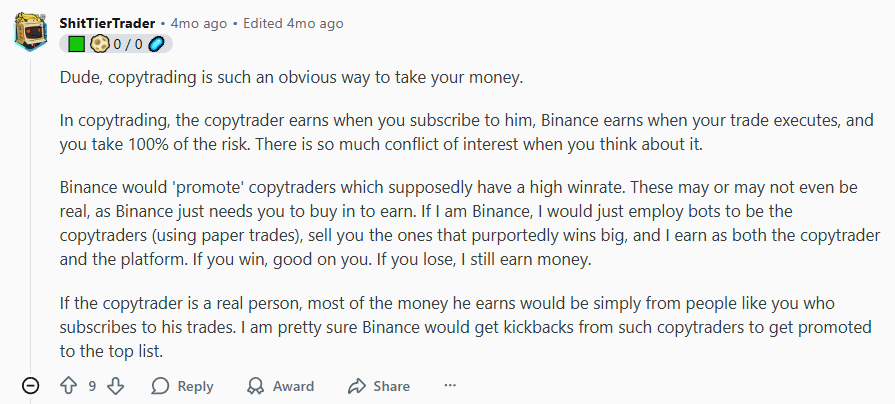
Market unpredictability. Even the best traders can’t foresee sudden price swings, flash crashes, or unexpected news, for example, like the one that happened on October 11. During extreme volatility, copied trades may execute at worse prices due to slippage, when the market moves faster than the order can be filled.
Platform reliability. Technical bugs, lagging APIs, or even short outages can break synchronization with your lead trader. In rare cases, security breaches or system failures have locked users out when they needed to act fast.
Your responsibility
Copy trading for beginners might seem promising and exciting, but it’s not a “plug-and-play” solution. Whether you’re using eToro copy trading, an exchange platform, or trading bots on 3Commas, you need to stay engaged and treat every trade as a learning experience. In the end, you’re the only one in charge of your money.

Disclaimer: All materials on this site are for informational purposes only. None of the material should be interpreted as investment advice. Please note that despite the nature of much of the material created and hosted on this website, HODL FM is not a financial reference resource, and the opinions of authors and other contributors are their own and should not be taken as financial advice. If you require advice. HODL FM strongly recommends contacting a qualified industry professional.





